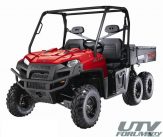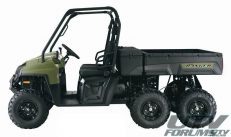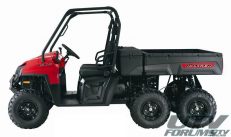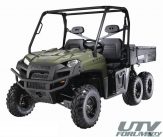The 2011 Polaris RANGER® 6×6 800 is built with unmatched traction and capacity. It’s the ultimate 6×6 side-by-side for farming, ranching, hunting, contracting & construction work. Key features are:
40 HP 760cc Twin-Cylinder EFI Engine
Independent Six-Wheel Suspension
On-Demand True Six-Wheel Drive (6WD)
2,000 lb. (907.2 kg) Payload/Towing Capacity
On-Demand True Six-Wheel Drive (6WD)True AWD keeps you moving, automatically engaging all six wheels when you need more forward traction and reverting back to the rear four wheels when you don’t.
Superior Ergonomics Cab ergonomics deliver outstanding driver and passenger comfort, including tilt steering with the highest range of motion (10″), extra legroom, and easy cab slide-through design for three adults to get in and out quickly.
Proven 800 EFI Engine 800 twin electronic fuel injection engine, cranks out 40 horse power
Large Dump Box With Lock & Ride Cargo System* Pallet-size rear dump box has gas-assist dumping operation and features exclusive Lock & Ride cargo system that accommodates many hard-working accessories that go on and off in seconds
Independent Rear Suspension IRS Six wheel independent rear suspension with 12″ of ground clearance
Monstrous 1-Ton Towing The strength to tow 2,000 lbs., far more than the competition, means you can tackle the toughest jobs with confidence. Features a standard 2″ hitch receiver.
Payload, Power, Storage Highlight New 800 6×6…
For 2010, Polaris has refined and polished almost every aspect of its 6×6. Polaris says that it appeals to farmers, outdoorsmen, land owners, contractors and municipalities that need massive storage capacity with unmatched terrain capabilities. We couldn’t agree more. Except to add that as UTV standards go, the six-wheeled beast is thunderously quick, both from a standstill and at speed. The 6×6 retains all of the key components that are so convincing to these buyers, but with significant improvements. “Just doing what the customer asks,” Polaris says.
Here’s what stands out about the new generation 6×6: new dual-A-arm front suspension, massive new storage box, adjustable “motion-ratio” suspension, new front-end design, new engine, tilt steering wheel, and gigantic payload / towing capacities.
Exterior / Features
Where the old design might be called something akin to squared-off, “retro-futuristic” (so old that it looks stylish), the new look takes the straight lines and flat planes from that canvas and turns them into crisp angled creases–particularly in the upward arching front face. It wasn’t just for splash either. Polaris says they wanted to create an exterior that could handle the nastiest work and the extreme riding conditions a 6×6 will take you. The end result was the most armored Ranger front end ever designed. Above and beyond the swoopy looks, the redesigned front end better protects vital components such as the radiator, cooling system and front differential. The front headlights were inset for added protection from rocks and branches. The redesigned bumper with a heavy-duty bash plate offers dedicated vehicle tie down points, a central tow hook and an inset tow hook cage. For working at night or finding your way to that favorite hunting spot before daybreak, engineers thoughtfully added pre-drilled auxiliary light mounting holes on the front bumper with bosses already installed for optional Halogen/LED distance headlights. Rear brakes for the 6×6 are attached to the drive shaft between the two rear axles
Rear brakes for the 6×6 are attached to the drive shaft between the two rear axles
A big, smiling, mouth-shaped grille area has a bold “POLARIS” logo on the black fascia center top and the newly certified ROPS bars have been raked a few degrees backward, helping to keep the profile from being too boxy. Slightly squared-off fender wells give a hint of truck styling, and the color-matched front hood and cargo bed help to reduce the overall visual length.
On the 2010 6×6, another practical advantage is the enormous truck-like toolbox. If you’re a mobile pack rat like me, this priceless gem is easily one of the best features we’ve yet seen on a UTV. Located between the cargo bed and the seat back, it offers padlock-ready latches and protects valuable tools with tight, water seal covers. The toolbox adds roughly 16-inches in overall length as compared to the 2009 6×6.
Ergonomics
The extended chassis that helped fit the toolbox also helps with a new, angled-back seat, offering slightly more seat and leg space. The gas & brake pedals have also been reoriented for operator comfort. Polaris says the 54-inch width between the hip bars fits three and added a middle seat belt to accommodate another rider.
Polaris also redesigned the steering wheel for better steering with gloves and added standard tilt steering with 10-inches range of motion for maximum comfort. Along with tilt steering, the new models have 50 percent easier steering, which helps maneuverability in tight areas, such as work sites or woods. Large bench seating is comfy for the long-haul, and the fabric appears to have been improved with a thicker, anti-tear vinyl with a different sculpted design in the material intended to help with “rump-slide.” It offers a better grip to your pants when cornering sharp or making emergency stops. Beneath the seat on the driver’s side is a huge 20-gallon storage container.
Even with all of these great features, there is room for improvement. The cab floor needs a makeover. It’s slippery and a different (and thicker) textured material should be considered. However, when climbing in or out of the cab area, there is a work-friendly 14-inch step to the ground which is lower than the 18-inch step for the Arctic Cat Prowler, 17-inches for the Kawasaki Teryx, and 16-inch Deere Gator 620i step.
Dash
 The Polaris crew compartment is well designed, roomy, and comfortable for three
The Polaris crew compartment is well designed, roomy, and comfortable for three
On the dash, the switchgear for lights and traction settings are pretty straightforward but are noteworthy for the upscale appearance the backlighting gives them. You’ll be glad to have them every time you ride at night. The cupholders and park brake lever have been repositioned for 2010. Situated on the far left of the dash for easy operation inside and outside of the vehicle is the parking brake lever. Three years ago, the parking brake pedal was mounted on the left side of the cab floor and I whined about it catching your leg pants, and the release handle as being sloppy. I have to give them kudos on the redesign. It’s also hard to overestimate how handy it is to have a brake lever with a warning light and engine stutter. If you try moving the Ranger with the brake on, the engine will begin stuttering as a reminder. There’s even a dash-light when the brake is set! Together the stuttering and warning light make it almost impossible to wear out the parking brake—unlike previous years’ models. There’s also a practical advantage to the parking brake being on the top far left. If you forget to set the brake and the machine begins rolling, you don’t have to jump back into a moving vehicle. Just (carefully) grab and pull from an arm’s length. The first time it happened to us, we saved the rear light lens because the vehicle was rolling directly back into a tree.
Other dash-mounted features include an easy to read digital instrument panel that houses a multi-function speedometer, hour meter, (2) trip meters, tachometer, fuel gauge, range selection indicator and parking brake warning light. At your right hand is the elegant and ergonomically sound range selection lever which requires less effort and range of motion to toggle between gears. It works great for back & forth tasks such as snowplowing. In our experience, the ATV manufacturers, like Polaris, have smoother operating levers than non-ATV manufacturers.
Suspension
All Ranger’s have suspension systems with a comfort factor you seldom find anywhere else. The longer and slimmer chassis that allowed for the toolbox to fit also allows for longer A-arms, which means greater wheel travel. The A-arms on the independent suspension system work such that each wheel is located on a “knuckle” connected by ball and CV-joints to upper and lower A-arms of unequal length. This keeps the wheel straight when moving up & down. The advantage is, the longer the A-arms, the greater their ability to change track and camber during cornering and riding over rocks or other trail obstacles. (Check out the front A-arms on the ’09 and ’10 Ranger photos above.)
Motion-Ratio Adjustable Shocks For working with heavy loads on a regular basis, riders can bolt the upper shock mount into a second location which stiffens the suspension for the added weight. It’s a great feature.
For working with heavy loads on a regular basis, riders can bolt the upper shock mount into a second location which stiffens the suspension for the added weight. It’s a great feature.
The new front independent suspension has a longer, dual A-arm setup with 9.6-inches of wheel travel. At the rear, the independent, dual A-arm suspension allows each wheel to articulate independently for maximum traction in uneven terrain. As expected, the ride is darn good for this segment –maybe too good. Over the years, we’ve often heard and experienced the way Rangers squat when loaded to their maximum capacity, and in response, engineers developed “motion-ratio adjustability.” The suspension can be dramatically stiffened by changing the position of the top shock bolt mount, giving it a straighter up & down configuration rather than angled inwards, which allows the shock to “work” more. Also, thanks to preload adjustability at each wheel, the initial spring compression can be increased for a 30 percent stiffer ride when needed for carrying a heavy load. When combined, the dual suspension adjustments help maintain 12-inches of ground clearance and consistent suspension travel, even when carrying heavier loads and using accessories such as plows, cabs, and sprayers for work applications. This is important stuff that shouldn’t be underestimated. We’ve heard from Ranger owners that believed smooth riding directly correlated to decreased hauling capacity. Some even perceived it as fudged payload capacities. Owners had trouble understanding why a max-capacity loaded cargo bed would squat way down and the front would pick up—making for difficult handling. This has now been fixed.
Changing the upper shock mounting bolt location on all six shocks takes an hour or so, and it’s not something you’ll be doing all the time. However, if you frequently carry heavy loads, just change them over to the firmer mount and use the preload adjustment on each shock to adjust for varying weights. It worked well for us. It does take away some of the “Polaris plushness,” but it’s worth the extra weight-carrying capacity. Ironically, because four rear shocks support the bed, the 6×6 doesn’t sag nearly as much as a four-wheeled Ranger. We really like the motion-ratio adjustability, but we wonder how many people will either not notice or care and this might be one of those exasperating examples of unrewarded excellence. We noticed and we liked it. All payload areas combined, the Ranger 6×6 has a whopping one-ton payload capacity – dump box (1,250-pounds), job box for tools (250-pounds), and a 500-pound capacity for passengers. If that wasn’t enough, a 2-inch hitch receiver is standard as well. With an extra set of drive wheels, traction on the 6×6 is outstanding, as is stability, even on steep hills.
With an extra set of drive wheels, traction on the 6×6 is outstanding, as is stability, even on steep hills.
To deal with ruts, stumps and rocks, 2010 Rangers also offer anti-kickback steering that reduces wheel feedback over bumps and makes the vehicle steerable with one hand. Should you find yourself pin-balling down some boulder-strewn ravine, however, you’ll be relieved to know that the 6×6 has full skid plates and CV-joint protection. It also has exceptional six-wheel braking. Polaris wisely installed the rear hydraulic brake disc directly on the rear driveshaft for 4-wheel braking, and the front tires have hydraulic discs as well.
Engine
A new 760cc Polaris Liberty 40HP twin-cylinder helps the weighty 1,550-pound 6×6 overcome the laws of physics and is the reason the 6×6 can carry a one-ton payload with a towing capacity to match. Acceleration is brisk with a top speed of 46 mph — the mega-power engine makes it the fastest and most powerful in the heavy-duty utility vehicle segment. Polaris paired this engine with a Bosch multi-port, semi-sequential electronic fuel injection system (EFI). The pairing makes the RANGER 6X6 responsive and reliable in the type of rugged, off-road terrain that demands sudden and extreme changes in both power requirements and variations in speed. A Throttle Position Sensor (TPS) in the EFI system ensures the engine delivers extremely precise response to driver input. The EFI also constantly and automatically compensates for changes in altitude, pressure and temperature, making it extremely reliable no matter where the rider chooses to go, and ensures the RANGER 6X6 engine starts instantly in all conditions, from –25 degrees F to 120 degrees F at altitudes up to 10,000 feet. We purposely left the 6×6 outside for four straight nights with low temps around 10-degrees. On the morning of the fifth day, we turned the key and it fired up instantly –enough said. The nine-gallon gas tank is one of the largest you’ll find for Utility Vehicles, and you’ll need every drop. We got about 7 hours of run time on 9 gallons.
Drivetrain / Traction
The new engine is mated to a CVT transmission with six-wheel shaft drive. The all-wheel-drive, “On-Demand” Polaris system electronically monitors all three sets of wheels and seamlessly transfers power back & forth if any are losing traction — a 6×6 will continue moving forward even when the four rear wheels are slipping. There’s a wrinkle in the traction control system that allows the wheels to slip more than usual in certain situations so it can “paddle” its way out of deep snow and mud. A Hilliard front differential offers “locked” front-wheel drive, yet allows one tire to rotate faster and still put power to the ground. It’s the best traction system available.
If you’re buying a 6×6, my guess is that you’ll be doing a little white-knuckle riding at some point anyway. Getting stuck in mud or snow in a 6×6 would be virtually impossible, and Polaris contends the six-wheel-drive system is “perhaps the most advanced ever offered in an off-road vehicle.” The all-wheel drive system is “on demand” and kicks in when the 6×6 starts to slip and slide. It was flawless for the entire test period, and we found the rear would barely break free before the fronts clawed for grip. Selecting the rocker switch on the dash is the only “demand” it makes on you.
Cargo Bed / Lock & Ride / Storage
 What can we say? WE LOVE THIS!
What can we say? WE LOVE THIS!
The versatile, polypropylene cargo box is the standard-size Ranger box. The 54-inch wide box will hold a normal shipping pallet, has a work-friendly, single-lever tailgate latch, and a self-cleaning gate hinge.
We’ve been asking manufacturers for years about offering dump box release levers on both sides of the vehicle, and Polaris finally came through. You can release the box for dumping on either side of the vehicle, and the assist lift is strong enough one person can dump it even when fully-loaded. In fact, the assist-lift is so strong that it takes two hands to lower it back down – nice; no need to order the power dump option.
With the tailgate down, the dump box has a 36-inch work height, which is a little high for loading convenience when compared to others in this segment. In front of the dump box, is an all new, truck-like job box with a 250-pound capacity. It’s such a useful feature, you will feel cheated without one. Made from tough, Roto-molded plastic, it features dual lid doors to access tools from either side and padlock-ready latches to keep tools from walking away. The 39-gallon capacity box has tongue & groove rubber gasket sealed lids to keep dirt, dust and water out. There are not enough words in the dictionary to describe how handy this is.
Summary
Off-road, the 6×6 is second to none. Its suspension allows for everything from maximum ground clearance to articulating six-wheel, terrain-grabbing traction. Everything works seamlessly together in getting you up & over or through anything you can throw at it. The balance between handling & comfort is as good as you’re going to get with a six-wheeled machine. The only other six-wheeled UTV that comes close in concept, the Gator TH 6×4– doesn’t come close. 













